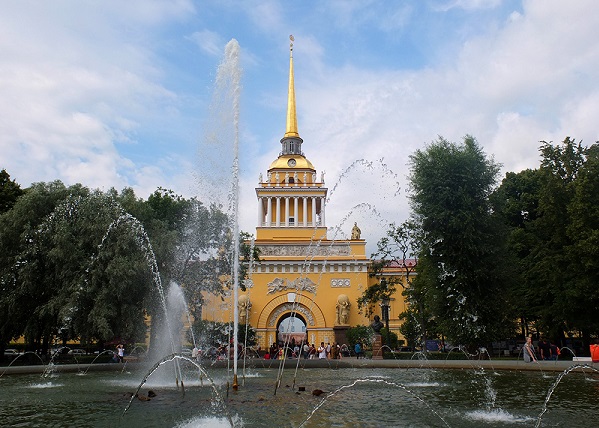Fountain at the Admiralty in St Petersburg

The history of the appearance of the most grandiose by the standards of the XIX century water-jet facilities began in the 70-ies in parallel with the arrangement on the site of the Admiralty meadows of the same garden, which soon became known as Alexander. According to the plan of Peter I, from the Admiralty had to move three lines, and already during the reign of Alexander II at the breakdown of the new garden in their target had planned to install three large bowls of fountains.
However, the project was not to be fully implemented. Due to the high cost and complexity of the proposed hydraulic works stopped at one fountain, and then on its arrangement on the sketch-drawing stage worked for several years a group of specialists. The original version of Merz, developed in 1872, was rejected, because his proposed 18-meter sculptural group would close the Admiralty and was considered costly. Benoit a few years later reworked the project, and completed its architect Geschwend.
After the approval of the documentation in 1876, construction works were started on the site in front of the Admiralty by the St. Petersburg merchant Ovchinnikov, which had been specially planned for the Alexander garden. The Grand opening took place in October 1879.
Until 2000, the round granite bowl of the fountain with a diameter of 24.6 meters, lying on the stone underground galleries, was considered the largest in the city. The bottom and sides of the cannon are made of brought from the quarries of the island Enisaari Serdobol (serdobolskiy) granite.
Surrounded by a tuff ring with Central jet shoots from the ground vertically up to 17 meters. Around it are 8 tubes: of them break out in the direction of the audience, as if bowing, silver water threads. A special charm of the fountain is added by another 40 jets, which circularly, one near the other, endlessly circling in a bizarre dance near the wall of the pool. But the name of the attraction was for the ability to change the height of the water flow depending on the rhythm of the music sounding in the garden.
A copy of the popular building is located on Manezh square.